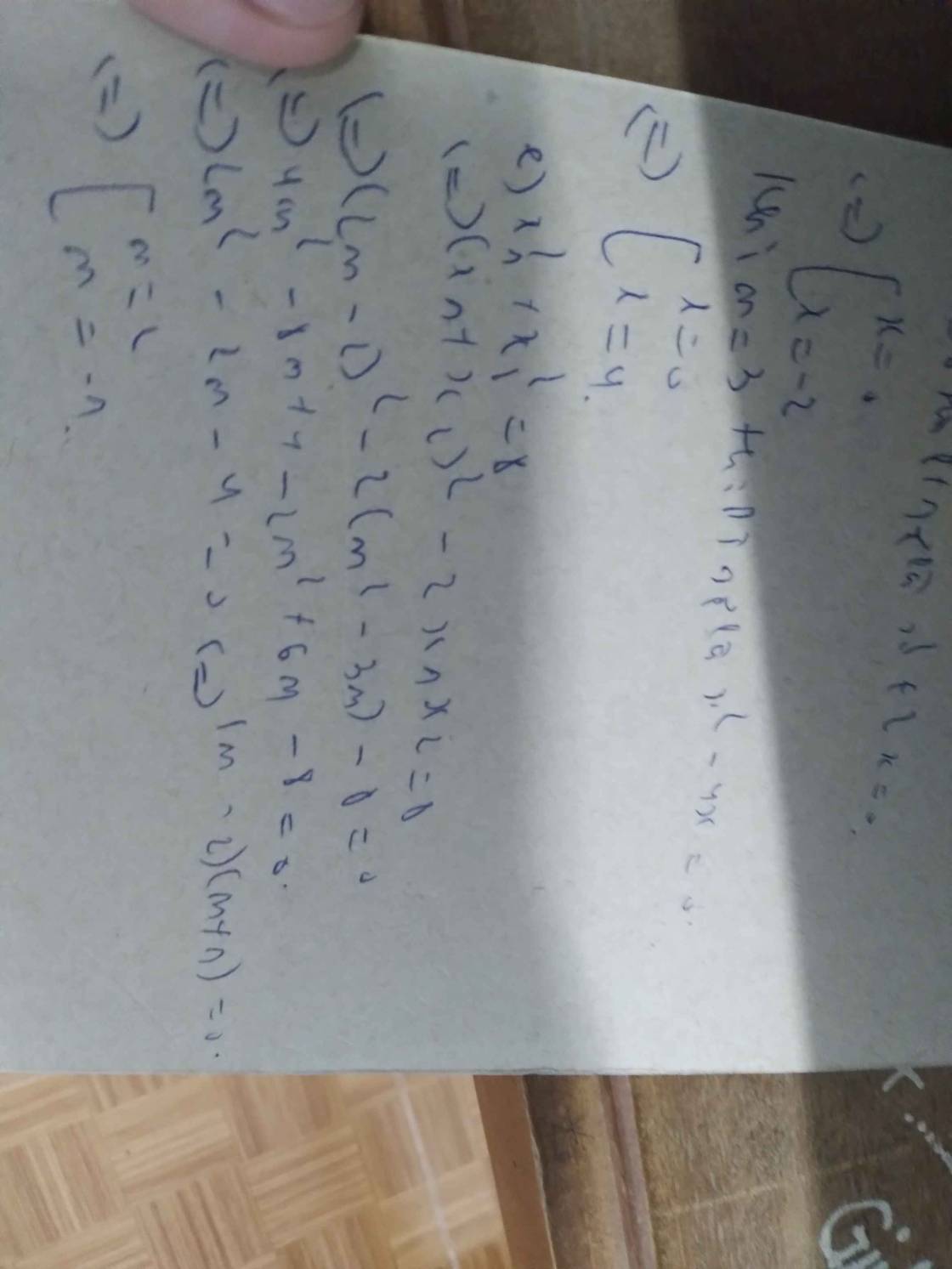Hãy nhập câu hỏi của bạn vào đây, nếu là tài khoản VIP, bạn sẽ được ưu tiên trả lời.

a: Thay x=5 vào pt, ta được:
5^2-2(m-1)*5+m^2-4m+3=0
=>m^2-4m+3+25-10m+10=0
=>m^2-14m+38=0
=>(m-7)^2=11
=>\(m=\pm\sqrt{11}+7\)
b: x1+x2=2m-2
x1*x2=m^2-4m+3
(x1+x2)^2-4x1x2
=4m^2-8m+4-4m^2+4m-6
=-4m-2
(x1+x2)^2-4x1x2+2(x1+x2)
=-4m-2+4m-4=-6

Bài 1:
a, Thay m=-1 vào (1) ta có:
\(x^2-2\left(-1+1\right)x+\left(-1\right)^2+7=0\\
\Leftrightarrow x^2+1+7=0\\
\Leftrightarrow x^2+8=0\left(vô.lí\right)\)
Thay m=3 vào (1) ta có:
\(x^2-2\left(3+1\right)x+3^2+7=0\\ \Leftrightarrow x^2-2.4x+9+7=0\\ \Leftrightarrow x^2-8x+16=0\\ \Leftrightarrow\left(x-4\right)^2=0\\ \Leftrightarrow x-4=0\\ \Leftrightarrow x=4\)
b, Thay x=4 vào (1) ta có:
\(4^2-2\left(m+1\right).4+m^2+7=0\\ \Leftrightarrow16-8\left(m+1\right)+m^2+7=0\\ \Leftrightarrow m^2+23-8m-8=0\\ \Leftrightarrow m^2-8m+15=0\\ \Leftrightarrow\left(m^2-3m\right)-\left(5m-15\right)=0\\ \Leftrightarrow m\left(m-3\right)-5\left(m-3\right)=0\\ \Leftrightarrow\left(m-3\right)\left(m-5\right)=0\\ \Leftrightarrow\left[{}\begin{matrix}m=3\\m=5\end{matrix}\right.\)
c, \(\Delta'=\left[-\left(m+1\right)\right]^2-\left(m^2+7\right)=m^2+2m+1-m^2-7=2m-6\)
Để pt có 2 nghiệm thì \(\Delta'\ge0\Leftrightarrow2m-6\ge0\Leftrightarrow m\ge3\)
Theo Vi-ét:\(\left\{{}\begin{matrix}x_1+x_2=2m+2\\x_1x_2=m^2+7\end{matrix}\right.\)
\(x_1^2+x_2^2=0\\ \Leftrightarrow\left(x_1+x_2\right)^2-2x_1x_2=0\\ \Leftrightarrow\left(2m+2\right)^2-2\left(m^2+7\right)=0\\ \Leftrightarrow4m^2+8m+4-2m^2-14=0\\ \Leftrightarrow2m^2+8m-10=0\\ \Leftrightarrow\left[{}\begin{matrix}m=1\left(ktm\right)\\m=-5\left(ktm\right)\end{matrix}\right.\)
\(x_1-x_2=0\\ \Leftrightarrow\left(x_1-x_2\right)^2=0\\ \Leftrightarrow\left(x_1+x_2\right)^2-4x_1x_2=0\\ \Leftrightarrow\left(2m+2\right)^2-4\left(m^2+7\right)=0\\ \Leftrightarrow4m^2+8m+4-4m^2-28=0\\ \Leftrightarrow8m=28=0\\ \Leftrightarrow m=\dfrac{7}{2}\left(tm\right)\)
Bài 2:
a,Thay m=-2 vào (1) ta có:
\(x^2-2x-\left(-2\right)^2-4=0\\ \Leftrightarrow x^2-2x-4-4=0\\ \Leftrightarrow x^2-2x-8=0\\ \Leftrightarrow\left[{}\begin{matrix}x=4\\x=-2\end{matrix}\right.\)
b, \(\Delta'=\left(-m\right)^2-\left(-m^2-4\right)\ge0=m^2+m^2+4=2m^2+4>0\)
Suy ra pt luôn có 2 nghiệm phân biệt
Theo Vi-ét:\(\left\{{}\begin{matrix}x_1+x_2=2\\x_1x_2=-m^2-4\end{matrix}\right.\)
\(x_1^2+x_2^2=20\\ \Leftrightarrow\left(x_1+x_2\right)^2-2x_1x_2=20\\ \Leftrightarrow2^2-2\left(-m^2-4\right)=20\\ \Leftrightarrow4+2m^2+8-20=0\\ \Leftrightarrow2m^2-8=0\\ \Leftrightarrow m=\pm2\)
\(x_1^3+x_2^3=56\\ \Leftrightarrow\left(x_1+x_2\right)^3-3x_1x_2\left(x_1+x_2\right)=56\\ \Leftrightarrow2^3-3\left(-m^2-4\right).2=56\\ \Leftrightarrow8-6\left(-m^2-4\right)-56\\ =0\\ \Leftrightarrow8+6m^2+24-56=0\\ \Leftrightarrow6m^2-24=0\\ \Leftrightarrow m=\pm2\)
\(x_1-x_2=10\\ \Leftrightarrow\left(x_1-x_2\right)^2=100\\ \Leftrightarrow\left(x_1+x_2\right)^2-4x_1x_2-100=0\\ \Leftrightarrow2^2-4\left(-m^2-4\right)-100=0\\ \Leftrightarrow4+4m^2+16-100=0\\ \Leftrightarrow4m^2-80=0\\ \Leftrightarrow m=\pm2\sqrt{5}\)

a.Bạn thế vào nhé
b.\(\Delta=3^2-4m=9-4m\)
Để pt vô nghiệm thì \(\Delta< 0\)
\(\Leftrightarrow9-4m< 0\Leftrightarrow m>\dfrac{9}{4}\)
c.Ta có: \(x_1=-1\)
\(\Rightarrow x_2=-\dfrac{c}{a}=-m\)
d.Theo hệ thức Vi-ét, ta có:
\(\left\{{}\begin{matrix}x_1+x_2=-3\\x_1.x_2=m\end{matrix}\right.\)
1/ \(x_1^2+x_2^2=34\)
\(\Leftrightarrow\left(x_1+x_2\right)^2-2x_1x_2=34\)
\(\Leftrightarrow\left(-3\right)^2-2m=34\)
\(\Leftrightarrow m=-12,5\)
..... ( Các bài kia tương tự bạn nhé )

Bài 2:
a: \(x^2-4x+3=0\)
=>x=1 hoặc x=3
\(x_1^2+x_2^2=1^2+3^2=10\)
b: \(\dfrac{1}{x_1+2}+\dfrac{1}{x_2+2}=\dfrac{1}{1}+\dfrac{1}{5}=\dfrac{6}{5}\)
c: \(x_1^3+x_2^3=1^3+3^3=28\)
d: \(x_1-x_2=1-3=-2\)

x^2-3x-(m-1)=0(1)
a)Dể phương trình có 2 nghiệm dương phân biệt:delta>0,S>0,P>0
9+4m-4>0>>>m>-5/4;S=3>0;P=m-1>0>>m>1.
>>>>Để(1) có 2 nghiệm phân biệt thì m>1.
b)x1^3+x2^3=18>>>(x1+x2)(x1^2-x1x2+x2^2)=18>>>x1^2-x1x2+x2^2=6
>>>(x1+x2)^2-3x1x2=6>>>3x1x2=3>>>x1x2=1
-(m-1)=1>>>m=0.
Vậy m=0

Bài 1:
a) Thay x=-2 vào phương trình, ta được:
\(\left(-2\right)^2-2m\cdot\left(-2\right)+2m-3=0\)
\(\Leftrightarrow4+4m+2m-3=0\)
\(\Leftrightarrow6m=-1\)
hay \(m=-\dfrac{1}{6}\)
Áp dụng hệ thức Vi-et, ta được:
\(x_1+x_2=2m\)
\(\Leftrightarrow x_2-2=\dfrac{-1}{3}\)
hay \(x_2=\dfrac{5}{3}\)
Bài 1:
b) Ta có: \(\Delta=\left(-2m\right)^2-4\cdot1\cdot\left(2m-3\right)\)
\(=4m^2-8m+12\)
\(=4m^2-2\cdot2m\cdot2+4+8\)
\(=\left(2m-2\right)^2+8>0\forall m\)
Do đó: Phương trình luôn có hai nghiệm phân biệt với mọi m
Áp dụng hệ thức Vi-et, ta được:
\(\left\{{}\begin{matrix}x_1+x_2=2m\\x_1\cdot x_2=2m-3\end{matrix}\right.\)
Để phương trình có hai nghiệm đều dương thì
\(\left\{{}\begin{matrix}\Delta>0\\x_1+x_2>0\\x_1\cdot x_2>0\end{matrix}\right.\Leftrightarrow\left\{{}\begin{matrix}2m>0\\2m-3>0\end{matrix}\right.\)
\(\Leftrightarrow\left\{{}\begin{matrix}m>0\\2m>3\end{matrix}\right.\Leftrightarrow\left\{{}\begin{matrix}m>0\\m>\dfrac{3}{2}\end{matrix}\right.\Leftrightarrow m>\dfrac{3}{2}\)



Thay \(x=2-\sqrt{3}\) vào Pt, ta được:
\(\left(2-\sqrt{3}\right)^2-3\left(2-\sqrt{3}\right)+k-1=0\)
\(\Leftrightarrow7-4\sqrt{3}-6+3\sqrt{3}+k-1=0\)
\(\Leftrightarrow k-\sqrt{3}=0\)
hay \(k=\sqrt{3}\)
\(x_1+x_2=3\)
nên \(x_2=3-2+\sqrt{3}=\sqrt{3}+1\)